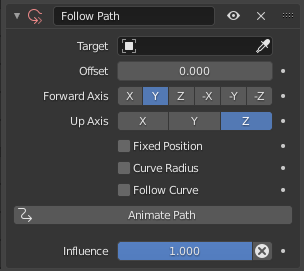Restricción Seguir trayectoria¶
La restricción Seguir trayectoria moverá un objeto a lo largo de una curva; en caso de activarse la opción, ajustará su rotación para alinearla con la dirección de la curva. Esta restricción será normalmente usada para:
Animar objetos a lo largo de trayectorias predefinidas, como por ejemplo, un vehículo sobre una pista o una cámara acompañando a elementos de una escena.
Simular sistemas mecánicos como cintas transportadoras o cadenas de bicicleta.
Controlar un movimiento de manera suave, sin que sea necesario animar cada movimiento manualmente mediante claves.
Truco
La restricción Seguir trayectoria funciona bien en conjunto con la restricción Apuntar (bloqueado). Por ejemplo, al animar una cámara a lo largo de una trayectoria, una restricción Apuntar (bloqueado) podría ayudar a controlar su ángulo de balanceo, fijándolo a un objetivo secundario.
Seguir trayectoria y Restringir a
Si bien ambas restricciones moverán objetos a lo largo de una curva, Seguir trayectoria se basa en el tiempo (el movimiento estará determinado por el fotograma actual), mientras que la restricción Restringir a establecerá la posición del objeto basándose en una propiedad de posición.
Evaluación en espacio del objeto¶
Nótese que la posición y rotación del objeto serán evaluadas en Espacio global:
Desplazamiento de posición: La posición del objeto actuará como un desplazamiento con respecto a su posición normal sobre la curva. Por ejemplo, un objeto con una posición de (1.0, 1.0, 0.0) será desplazado en una unidad a lo largo de los ejes X e Y a partir de su posición sobre la trayectoria. Para colocar el objeto exactamente sobre la curva, se podrá restablecer su posición usando el atajo Alt-G.
Influencia de la escala: El desplazamiento del objeto será afectado por la escala de la curva. Si la curva tuviera una escala de (2.0, 1.0, 1.0), el mismo desplazamiento de (1.0, 1.0, 0.0) se duplicaría en el eje X, mientras que en el eje Y permanecería incambiado.
Alineación de la rotación: Cuando la opción Seguir curva estuviera activa, la rotación del objeto acompañará la dirección de la curva. Para asegurar una correcta alineación, los ejes del objeto deberán estar apropiadamente alineados antes de aplicar la restricción. Restablecer la rotación usando el atajo Alt-R podría ser de ayuda.
Control del movimiento a lo largo de la trayectoria¶
El movimiento del objeto a lo largo de la curva podrá ser controlado de distintas maneras:
Temporización de animación de trayectoria: El movimiento estará determinado por las opciones de Animación de trayectoria de la curva, en sus Propiedades de Datos. El valor Fotogramas definirá la duración y la opción Desplazamiento de la propia restricción permitirá desplazar el fotograma inicial.
Animación personalizada mediante curvas-f: Para un control más preciso, será posible agregar una curva-f a la opción Tiempo de evaluación de la curva, para controlar desde el Editor de curvas el movimiento con mayor precisión.
Objeto estacionario sobre la trayectoria: En caso de que un objeto debiera permanecer en un punto fijo de la curva, será posible usar una curva-f plana, en donde el valor de la curva determinará la posición a lo largo de la trayectoria.
Opciones¶

Panel de Seguir trayectoria.¶
- Destino
Un ID de datos usado para seleccionar el objetivo (una curva) de la restricción; no será funcional en caso de encontrarse vacío (en color rojo). Ver propiedades comunes de restricciones para más información.
- Desplazamiento
Desplazará (en fotogramas) la posición del objeto a lo largo de la curva (relativo a las opciones de animación).
- Eje de avance
El eje del objeto que deberá estar alineado co la dirección de avance por la trayectoria. Será afectado en caso de que la opción Seguir curva se encontrara activa.
- Eje superior
El eje del objeto que deberá estar alineado (tanto como sea posible) con el eje Z global. De hecho, con esta opción activa, el comportamiento del propietario compartirá algunas propiedades con el causado por una restricción Apuntar (bloqueado), con la trayectoria actuando como «eje» y el eje Z global como un «imán». Se verá afectado en caso de que la opción Seguir curva se encontrara activa.
- Posición fija
Fijará al objeto a una posición específica a lo largo de la curva, sin importar la animación existente.
- Radio de la curva
Permitirá que el objeto se escale en base al radio de la curva. Ver Edición de curvas.
- Seguir curva
Cuando esta opción estuviera inactiva, la rotación del propietario no será modificada por la curva; en caso contrario será afectada dependiendo de los ejes de avance y superior.
- Animar trayectoria
Creará una curva-f para controlar el movimiento del objeto a lo largo de la trayectoria.
Tiempo de evaluación de los claves de animación
Para animar el movimiento a lo largo de una trayectoria de forma manual, se deberán insertar claves en el Tiempo de evaluación de la curva:
Seleccionar la curva e ir al panel Animación de trayectoria en las Propiedades de Datos de la curva.
En el primer fotograma (p.ej: el 1), establecer el Tiempo de evaluación en el valor inicial (p.ej: 1).
Hacer clic derecho sobre la opción Tiempo de evaluación y seleccionar Insertar clave.
Moverse hasta el fotograma final (p.ej: el 100), establecer la opción Tiempo de evaluación en su valor final (p.ej: 100).
Insertar otro clave.
Esto permitirá un control total sobre el movimiento del objeto sobre la curva.
- Influencia
Controla el porcentaje de efecto que la restricción ejercerá sobre el objeto. Ver propiedades comunes de restricciones para más información.